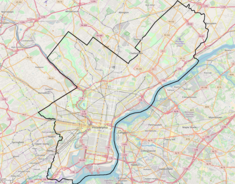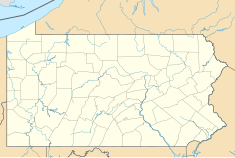| Fairmount Park, Lemon Hill | |
| U.S. National Register of Historic Places | |
| U.S. Historic district Contributing property | |
| Philadelphia Register of Historic Places | |
 Rear elevation with oval wall Rear elevation with oval wall | |
   | |
| Location | Philadelphia, Pennsylvania |
|---|---|
| Coordinates | 39°58′15″N 75°11′14″W / 39.97083°N 75.18722°W / 39.97083; -75.18722 |
| Built | c. 1800 |
| Architect | Henry Pratt |
| Architectural style | Federal |
| NRHP reference No. | 72001151 |
| Significant dates | |
| Designated CP | February 7, 1972 |
| Designated PRHP | June 26, 1956 |
Lemon Hill is a Federal-style mansion in Fairmount Park, Philadelphia, built from 1799 to 1800 by Philadelphia merchant Henry Pratt. The house is named after the citrus fruits that Pratt cultivated on the property in the early 19th century.
History and architecture
The mansion is situated on a parcel of land formerly part of Robert Morris's 300-acre (120 ha) estate, "The Hills." In 1799 Pratt purchased 43 acres (17 ha) of "The Hills" and accompanying structures at a sheriff's sale for $14,654 after occupant Morris suffered financial misfortunes and was taken to debtors' prison. Pratt designed the house and supervised its construction, though he did not live year-round at Lemon Hill: his primary residence was in a townhouse on Front Street.
Lemon Hill is located on a bluff overlooking the Schuylkill River and Boathouse Row. Exceptional architectural features include its three oval parlors, stacked one on top of the other, with curved fireplace mantles and doors. Pratt also landscaped the property in the English landscape garden style, extended a greenhouse structure Morris had built, and opened the grounds to the public for an entry fee.

To protect its water supply, the City of Philadelphia began purchasing properties along the Schuylkill River, beginning with Lemon Hill in 1844. The Lemon Hill estate was the first to be incorporated into the new Fairmount Park in 1855. During the second half of the 19th century, the mansion was used as a restaurant and received substantial modifications to its exterior, including a Victorian cast-iron porch.
From 1926 to 1955, the house was used as a residence by the first director of the Philadelphia Museum of Art, Fiske Kimball, and his wife Marie Goebel Kimball. Both architectural historians, the couple restored Lemon Hill to its 1800 appearance. Kimball conjectured that Robert Morris had built the mansion; however, in 2005, Pratt's letterbooks were found at the William L. Clements Library of the University of Michigan, Ann Arbor by an assistant curator of the Art Museum. Tax records indicated that the mansion did not exist at the time Pratt had purchased the land. The records also revealed that Pratt was both the designer and general contractor for his mansion.
The house was added to the National Register of Historic Places on February 7, 1972, as an inventoried contributing structure within Fairmount Park.
Since 1957, Lemon Hill Mansion has been operated as a house museum by the Colonial Dames of America and the Friends of Lemon Hill. Long hidden by dense trees on the sides of the hill, a restoration of the historic views was undertaken in 2007, recreating the original vistas of, and from, the mansion. The Fairmount Park Conservancy has managed the house since 2016.
See also
References
- Moss, Roger W.; Crane, Tom (1998). Historic Houses of Philadelphia: A Tour of the Region's Museum Homes. Philadelphia: University of Pennsylvania Press.
- Webster, Richard (1976). Philadelphia Preserved. Philadelphia: Temple University Press.
- ^ "National Register Information System – Fairmount Park (#72001151)". National Register of Historic Places. National Park Service. November 2, 2013. Retrieved November 2, 2017.
- ^ "National Register of Historic Places Inventory - Nomination Form". (archive) by George B. Tatum of the Philadelphia Historical Commission. dot7.state.pa.us. National Park Service document via the Commonwealth of Pennsylvania's Cultural Resources Geographic Information System, the Department of Transportation website and the records of the Pennsylvania Historical and Museum Commission. January 11, 1972. Retrieved November 7, 2017.
- ^ "200 Years of Splendor in Fairmount Park" (archive). lemonhill.org. Colonial Dames of America and the Friends of Lemon Hill. June 14, 2005. Retrieved November 7, 2017.
- ^ "Henry Pratt's Account for Lemon Hill". by Martha Halpern. antiquesandfineart.com. Antiques and Fine Art Magazine. June 2005. Retrieved November 7, 2017.
- Tasker Robbins, Owen (1987). "Toward a Preservation of the Grounds of Lemon Hill in Light of Their Past and Present Significance for Philadelphia". University of Pennsylvania Scholarly Commons.
- Lemon Hill viewscape restoration (archive)
- "Chapter II - Philadelphia, PA". 1890 - The Colonial Dames of America. 2014-08-01. Retrieved 2020-01-10.
- "Lemon Hill —". parkcharms.com. Retrieved 2020-01-10.
External links
 Media related to Lemon Hill at Wikimedia Commons
Media related to Lemon Hill at Wikimedia Commons- Lemon Hill Mansion history (archive)
- Historic American Buildings Survey (HABS) documentation:
- HABS No. PA-1010, "Lemon Hill", 32 photos, 2 color transparencies, 2 measured drawings, 9 data pages, 5 photo caption pages
- HABS No. PA-6184, "Schuylkill River Villas", 18 data pages of historical context
- Images of Lemon Hill in the David J. Kennedy Collection at the Historical Society of Pennsylvania
- Search historic photographs at PhillyHistory.org
- Historic district contributing properties in Philadelphia
- Historic house museums in Philadelphia
- Philadelphia Register of Historic Places
- Houses completed in 1801
- Federal architecture in Pennsylvania
- North Philadelphia
- Houses in Fairmount Park
- Houses on the National Register of Historic Places in Philadelphia
- Historic American Buildings Survey in Philadelphia
- East Fairmount Park